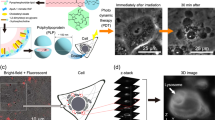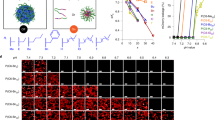Abstract
Pyroptosis is a gasdermin-mediated programmed necrosis that occurs via membrane perforation and that can be exploited for biomedical applications in cancer therapy. However, inducing specific pyroptotic cancer cell death while sparing normal cells is challenging. Here, we report an acid-activatable nanophotosensitizer library that can be used to spatiotemporally target distinct stages of endosomal maturation, enabling tunable cellular pyroptosis. Specific activation of phospholipase C signalling transduction in early endosomes triggers gasdermin-E-mediated pyroptosis, which is dramatically reduced when acid-activatable nanophotosensitizers are transported into late endosomes/lysosomes. This nanotuner platform induces pyroptotic cell death with up to 40-fold tunability in various gasdermin-E-positive human cancers, resulting in enhanced anti-tumour efficacy and minimized systemic side effects. This study offers new insights into how to engineer nanomedicines with tunable pyroptosis activity through specific targeting of distinct endocytic signalling for biomedical applications.
This is a preview of subscription content, access via your institution
Access options
Access Nature and 54 other Nature Portfolio journals
Get Nature+, our best-value online-access subscription
$29.99 / 30 days
cancel any time
Subscribe to this journal
Receive 12 print issues and online access
$259.00 per year
only $21.58 per issue
Buy this article
- Purchase on Springer Link
- Instant access to full article PDF
Prices may be subject to local taxes which are calculated during checkout






Similar content being viewed by others
Data availability
Source data are provided with this paper. The main data that support the findings of this study are available within the paper, the source data and the Supplementary Information. The GEPIA database is accessible via http://gepia.cancer-pku.cn/. Other raw and relevant data from the study are available for research purposes from the corresponding authors upon reasonable request.
References
Bergsbaken, T., Fink, S. L. & Cookson, B. T. Pyroptosis: host cell death and inflammation. Nat. Rev. Microbiol. 7, 99–109 (2009).
Shi, J. et al. Cleavage of GSDMD by inflammatory caspases determines pyroptotic cell death. Nature 526, 660–665 (2015).
Broz, P., Pelegrin, P. & Shao, F. The gasdermins, a protein family executing cell death and inflammation. Nat. Rev. Immunol. 20, 143–157 (2020).
Wang, Y. et al. Chemotherapy drugs induce pyroptosis through caspase-3 cleavage of a gasdermin. Nature 547, 99–103 (2017).
Rogers, C. et al. Cleavage of DFNA5 by caspase-3 during apoptosis mediates progression to secondary necrotic/pyroptotic cell death. Nat. Commun. 8, 14128 (2017).
Zhang, Z. et al. Gasdermin E suppresses tumour growth by activating anti-tumour immunity. Nature 579, 415–420 (2020).
Wang, Q. et al. A bioorthogonal system reveals antitumour immune function of pyroptosis. Nature 579, 421–426 (2020).
Mirshafiee, V. et al. Toxicological profiling of metal oxide nanoparticles in liver context reveals pyroptosis in Kupffer cells and macrophages versus apoptosis in hepatocytes. ACS Nano 12, 3836–3852 (2018).
Reisetter, A. C. et al. Induction of inflammasome-dependent pyroptosis by carbon black nanoparticles. J. Biol. Chem. 286, 21844–21852 (2011).
Zhang, X. et al. Mesoporous silica nanoparticles induced hepatotoxicity via NLRP3 inflammasome activation and caspase-1-dependent pyroptosis. Nanoscale 10, 9141–9152 (2018).
Ploetz, E. et al. Metal–organic framework nanoparticles induce pyroptosis in cells controlled by the extracellular pH. Adv. Mater. 32, e1907267 (2020).
Sorkin, A. & von Zastrow, M. Endocytosis and signalling: intertwining molecular networks. Nat. Rev. Mol. Cell Biol. 10, 609–622 (2009).
Borkowska, M. et al. Targeted crystallization of mixed-charge nanoparticles in lysosomes induces selective death of cancer cells. Nat. Nanotechnol. 15, 331–341 (2020).
Kim, S. E. et al. Ultrasmall nanoparticles induce ferroptosis in nutrient-deprived cancer cells and suppress tumour growth. Nat. Nanotechnol. 11, 977–985 (2016).
Zhang, Y. et al. Tuning the autophagy-inducing activity of lanthanide-based nanocrystals through specific surface-coating peptides. Nat. Mater. 11, 817–826 (2012).
He, B. et al. Single-walled carbon-nanohorns improve biocompatibility over nanotubes by triggering less protein-initiated pyroptosis and apoptosis in macrophages. Nat. Commun. 9, 2393 (2018).
Ma, X. et al. Ultra-pH-sensitive nanoprobe library with broad pH tunability and fluorescence emissions. J. Am. Chem. Soc. 136, 11085–11092 (2014).
Zhou, K. et al. Tunable, ultrasensitive pH-responsive nanoparticles targeting specific endocytic organelles in living cells. Angew. Chem. Int. Ed. 50, 6109–6114 (2011).
Wang, Y. et al. A nanoparticle-based strategy for the imaging of a broad range of tumours by nonlinear amplification of microenvironment signals. Nat. Mater. 13, 204–212 (2014).
Moan, J. & Berg, K. The photodegradation of porphyrins in cells can be used to estimate the lifetime of singlet oxygen. Photochem. Photobiol. 53, 549–553 (1991).
Wang, C. et al. A nanobuffer reporter library for fine-scale imaging and perturbation of endocytic organelles. Nat. Commun. 6, 8524 (2015).
Luo, M. et al. A STING-activating nanovaccine for cancer immunotherapy. Nat. Nanotechnol. 12, 648–654 (2017).
Castano, A. P., Demidova, T. N. & Hamblin, M. R. Mechanisms in photodynamic therapy: part two—cellular signaling, cell metabolism and modes of cell death. Photodiagnosis Photodyn. Ther. 2, 1–23 (2005).
Sun, L. et al. Mixed lineage kinase domain-like protein mediates necrosis signaling downstream of RIP3 kinase. Cell 148, 213–227 (2012).
Rogers, C. et al. Gasdermin pores permeabilize mitochondria to augment caspase-3 activation during apoptosis and inflammasome activation. Nat. Commun. 10, 1689 (2019).
Kang, R. et al. Lipid peroxidation drives gasdermin D-mediated pyroptosis in lethal polymicrobial sepsis. Cell Host Microbe 24, 97–108.E4 (2018).
Agarwal, M. L., Larkin, H. E., Zaidi, S. I., Mukhtar, H. & Oleinick, N. L. Phospholipase activation triggers apoptosis in photosensitized mouse lymphoma cells. Cancer Res. 53, 5897–5902 (1993).
Wang, Y. & Wang, Z. Regulation of EGF-induced phospholipase C-γ1 translocation and activation by its SH2 and PH domains. Traffic 4, 618–630 (2003).
Lee, G. S. et al. The calcium-sensing receptor regulates the NLRP3 inflammasome through Ca2+ and cAMP. Nature 492, 123–127 (2012).
Chen, K. et al. Deficiency in the membrane protein Tmbim3a/Grinaa initiates cold-induced ER stress and cell death by activating an intrinsic apoptotic pathway in zebrafish. J. Biol. Chem. 294, 11445–11457 (2019).
Kuchay, S. et al. PTEN counteracts FBXL2 to promote IP3R3– and Ca2+-mediated apoptosis limiting tumour growth. Nature 546, 554–558 (2017).
Martins, W. K. et al. Parallel damage in mitochondria and lysosomes is an efficient way to photoinduce cell death. Autophagy 15, 259–279 (2019).
Eskelinen, E. L., Tanaka, Y. & Saftig, P. At the acidic edge: emerging functions for lysosomal membrane proteins. Trends Cell Biol. 13, 137–145 (2003).
Reiners, J. J. Jr, Agostinis, P., Berg, K., Oleinick, N. L. & Kessel, D. Assessing autophagy in the context of photodynamic therapy. Autophagy 6, 7–18 (2010).
Sendler, M. et al. Cathepsin B activity initiates apoptosis via digestive protease activation in pancreatic acinar cells and experimental pancreatitis. J. Biol. Chem. 291, 14717–14731 (2016).
Mitsunaga, M. et al. Cancer cell-selective in vivo near infrared photoimmunotherapy targeting specific membrane molecules. Nat. Med. 17, 1685–1691 (2011).
Yin, Q. et al. Quantitative imaging of intracellular nanoparticle exposure enables prediction of nanotherapeutic efficacy. Nat. Commum 12, 2385 (2021).
Wang, X. et al. Polycarbonate-based ultra-pH sensitive nanoparticles improve therapeutic window. Nat. Commum 11, 5828 (2020).
Wang, S. et al. Arginine-rich manganese silicate nanobubbles as a ferroptosis-inducing agent for tumor-targeted theranostics. ACS Nano 12, 12380–12392 (2018).
Acknowledgements
This work was supported by the National Key Research and Development Program of China (2017YFA0205600 and 2016YFA0201400 to Yiguang Wang), National Natural Science Foundation of China grants (81622046 and 81973260 to Yiguang Wang and 81903554 to B.C.) and the Beijing Natural Science Foundation (JQ19025 to Yiguang Wang).
Author information
Authors and Affiliations
Contributions
B.C. and Yiguang Wang are responsible for all phases of the research. Y. Yan, Yaoqi Wang and F.W. helped with the characterization and efficacy evaluation of the nanophotosensitizer library. Z.W. helped with the synthesis and characterization of copolymers. X.W., Y.L. and L.W. performed the CRISPR-Cas9 knockout cell lines. Y. Yang and G.C. participated in the western blot. Q.Y. and B.X. performed the in vitro cell imaging and in vivo imaging. B.C. and Yiguang Wang wrote the manuscript. F.Y., Q.Z. and Yiguang Wang provided conceptual advice and supervised the study. All the authors discussed the results and assisted in the preparation of the manuscript.
Corresponding authors
Ethics declarations
Competing interests
The authors declare no competing interests.
Peer review
Peer review information
Nature Nanotechnology thanks Xiaoyuan Chen, Roger Gomis and the other, anonymous, reviewer(s) for their contribution to the peer review of this work.
Additional information
Publisher’s note Springer Nature remains neutral with regard to jurisdictional claims in published maps and institutional affiliations.
Supplementary information
Supplementary Information
Supplementary Figs. 1–53, Tables 1–4, Discussion and Methods.
Supplementary Video 1
PDTee can induce rapid membrane ballooning and pyroptotic cell death on A549 cells. A549 cells were incubated with ANPS6.5 (6 μg ml–1) for 15 min and immediately irradiated at 100 mW cm−2 for 1 min. Shown is the video of a representative field recorded immediately after irradiation. PI is used to indicate membrane rupture and dead cells. (The exact time duration is in hours:minutes:seconds:milliseconds).
Supplementary Video 2
PDTly switched off pyroptosis on A549 cells. A549 cells were incubated with ANPS6.5 (6 μg ml–1) for 15 min and then irradiated (100 mW cm−2 for 1 min) 2 h post micelle incubation. Shown is the video of a representative field recorded immediately after irradiation. PI is used to indicate membrane rupture and dead cells. (The exact time duration is in hours:minutes:seconds:milliseconds).
Supplementary Video 3
Knockout of GSDME switches PDTee-induced pyroptosis to apoptosis in A549 cells. GSDME–/– A549-GFP cells were incubated with ANPS6.5 (6 μg ml–1) for 15 min and immediately irradiated at 100 mW cm−2 for 1 min. Shown is the video of a representative field recorded immediately after irradiation. (The exact time duration is in hours:minutes:seconds:milliseconds).
Supplementary Video 4
Knockout of GSDMD cannot switch PDTee-induced pyroptosis to apoptosis in A549 cells. GSDMD–/– A549-GFP cells were incubated with ANPS6.5 (6 μg ml–1) for 15 min and immediately irradiated at 100 mW cm−2 for 1 min. Shown is the video of a representative field recorded immediately after irradiation. (The exact time duration is in hours:minutes:seconds:milliseconds).
Supplementary Video 5
PDTee can elevate the calcium ion signal in cytosol. A549 cells were incubated with ANPS6.5 (6 μg ml–1) for 15 min and immediately irradiated at 100 mW cm−2 for 1 min. Shown is the video of a representative field recorded immediately after irradiation. A fluo3 AM probe is used to indicate cellular calcium ion signal. (The exact time duration is in hours:minutes:seconds:milliseconds).
Supplementary Video 6
PDTly can slightly elevate the calcium ion signal in cytosol. A549 cells were incubated with ANPS6.5 (6 μg ml–1) for 15 min and then irradiated (100 mW cm−2 for 1 min) 2 h post micelle incubation. Shown is the video of a representative field recorded immediately after irradiation. A fluo3 AM probe is used to indicate cellular calcium ion signal. (The exact time duration is in hours:minutes:seconds:milliseconds).
Source data
Source Data Fig. 2
Statistical source data.
Source Data Fig. 3
Statistical source data.
Source Data Fig. 4
Statistical source data.
Source Data Fig. 5
Statistical source data.
Source Data Fig. 6
Statistical source data.
Rights and permissions
About this article
Cite this article
Chen, B., Yan, Y., Yang, Y. et al. A pyroptosis nanotuner for cancer therapy. Nat. Nanotechnol. 17, 788–798 (2022). https://doi.org/10.1038/s41565-022-01125-0
Received:
Accepted:
Published:
Issue Date:
DOI: https://doi.org/10.1038/s41565-022-01125-0
This article is cited by
-
Angelica acutiloba Kitagawa flower induces A549 cell pyroptosis via the NF-κB/NLRP3 pathway for anti-lung cancer effects
Cell Division (2023)
-
The role of pyroptosis and gasdermin family in tumor progression and immune microenvironment
Experimental Hematology & Oncology (2023)
-
pH-gated nanoparticles selectively regulate lysosomal function of tumour-associated macrophages for cancer immunotherapy
Nature Communications (2023)
-
Nanomedicine in cancer therapy
Signal Transduction and Targeted Therapy (2023)
-
Recent advances of bioresponsive polymeric nanomedicine for cancer therapy
Nano Research (2023)



